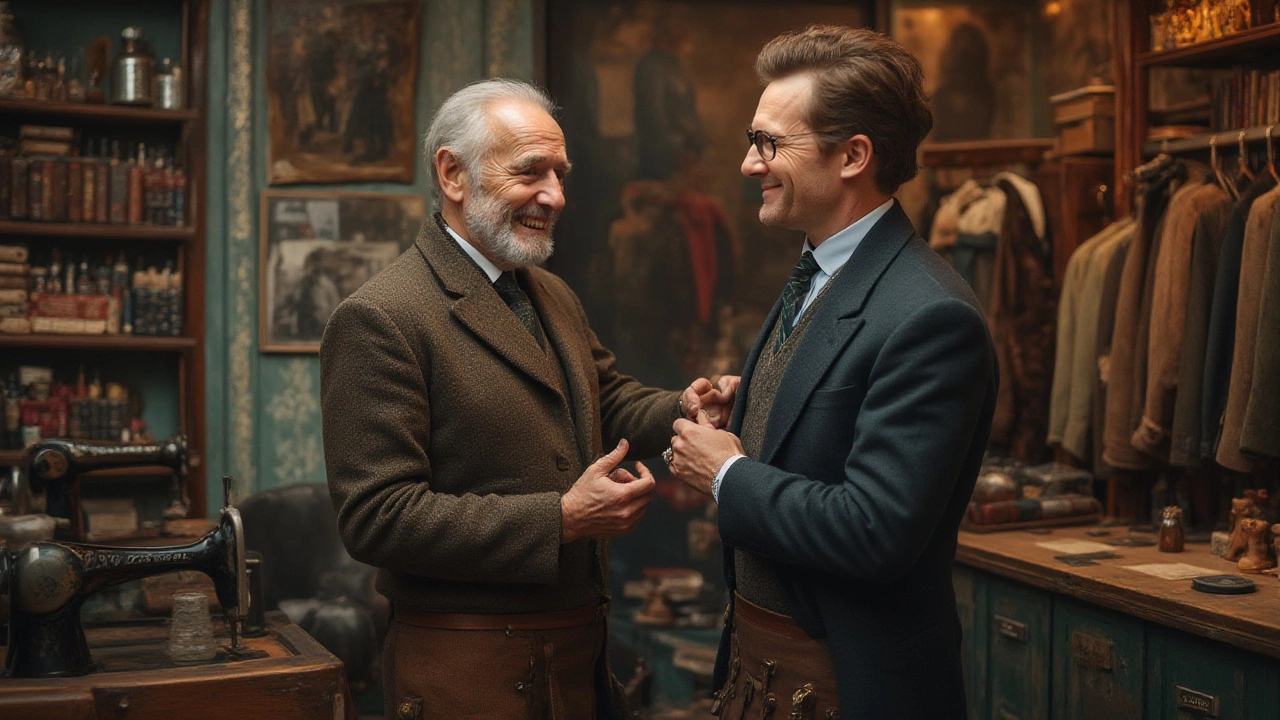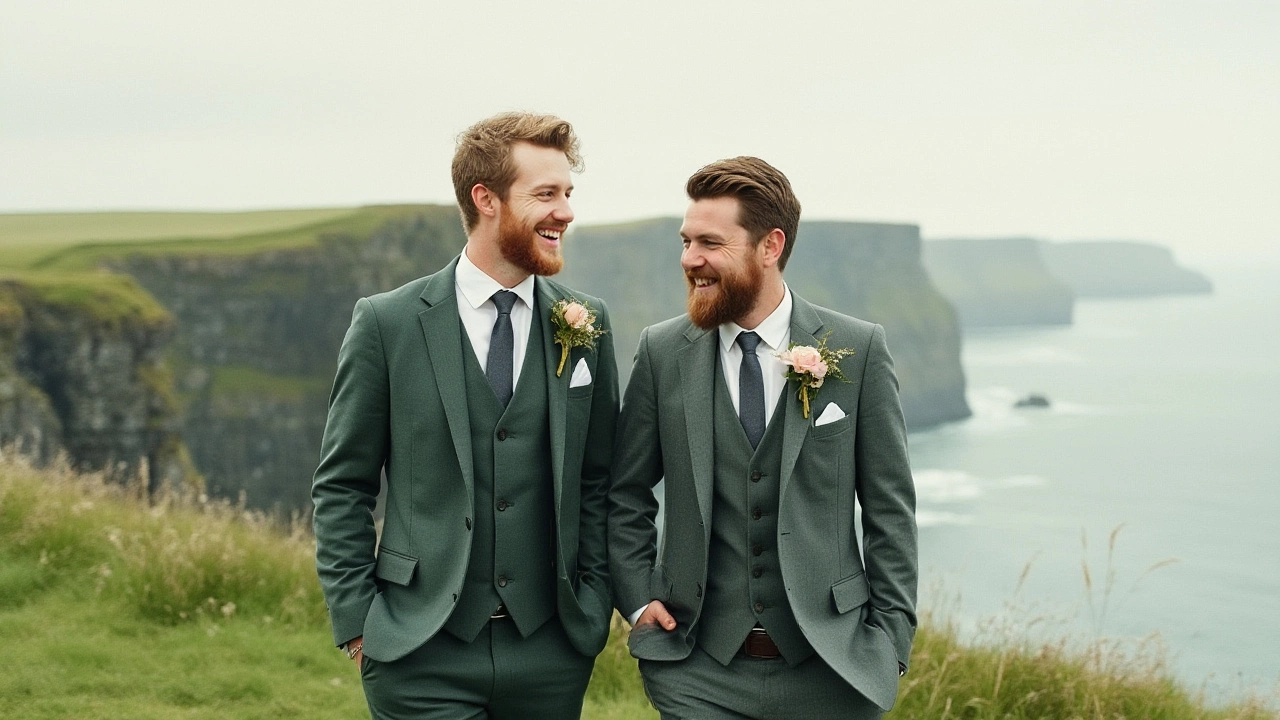Picture this: you’re walking into a swanky event at The Shelbourne or squeezing into a crowded Luas carriage headed into town, and there’s one burning question popping up for every gent and a fair few ladies in Ireland – should that suit hug the body or drape a little looser? It’s not just a wardrobe dilemma; it’s got roots in Irish culture, weather, lifestyle, and the kind of suit-worthy moments we bounce between, from weddings in Kerry to work meetings on St. Stephen’s Green. The way a suit fits in Ireland is about more than just style; it’s about comfort, confidence, and handling those classic four-seasons-in-a-day sessions. No matter if you're grabbing something off the rack from Brown Thomas or splashing out on a tailored piece at Louis Copeland, knowing how a suit should fit here is a bit like finding the perfect pint – subtle balance, a bit of trial and error, and a hint of local wisdom. Let’s break down what actually works best for the Irish suit-wearer, and why the tight-or-loose debate is more nuanced than you might think.
Suits and Weather: Fitting for Irish Seasons
Ireland is famous for its weather unpredictability – it could be raining buckets on Grafton Street and blazing sunshine half an hour later at Howth pier. This twisty climate makes suit choices more complicated than you’d expect. If you’re wondering if your suit should be tight or loose, start by thinking about the fabric and how much air you need between you and your jacket.
Thick wools, which are still a staple in Irish menswear, are much more comfortable with a bit of room to breathe. Anyone who's ever traipsed to a wedding at Dromoland Castle in July can tell you – a suit that’s too tight will have you sweating buckets and praying for an early exit. A loose fit, especially in classic cuts, gives you a fighting chance at avoiding the dreaded sweat patches and tight-collar headaches. On the other hand, slimmer cuts (not skinny) can help block wind on those blustery days, particularly in cities like Galway or Cork where the Atlantic breeze doesn’t mess around.
When it comes to double-breasted jackets, Irish tradition leans towards a slightly roomier cut. That said, styles are shifting – stores like Magee 1866 and Henry Jermyn are pushing more fitted, modern shapes. Still, you’ll find that even in these shops, expert tailors will ask about your typical commute and whether you spend a lot of time outdoors versus in boardrooms; they know that Irish weather matters when picking the right fit. A suit needs to flex for sudden showers with an umbrella or slipping a raincoat over for city sprints. Too tight, and layering becomes impossible. Too loose, and you risk feeling a bit lost in your outfit when the sun peeks through the clouds.
Fabrics like linen and lightweight blends are becoming more popular, especially for summer dos on the Aran Islands or outdoor corporate events around Dublin Docklands. These typically need a looser fit to avoid clinginess, as Irish humidity can make fabrics stick where you don’t want them. Still, the secret is in balance – enough space for comfort, not so much it looks baggy in wedding photos. Ask any tailor at Louis Copeland, and they’ll remind you: pure tightness or slackness just doesn’t survive an Irish downpour or cold snap.
So, when someone asks whether a suit in Ireland should be tight or loose, the honest answer? It depends on what you're dressing for, where you’re going, and how willing you are to risk comfort for trend. Always factor in our stubbornly mercurial weather, because your suit needs to pivot with you from drizzle to shine in a day’s notice. Just don’t forget an umbrella – that’s the real Irish accessory.
The Culture and Traditions of Suit Wearing in Ireland
If you look at old black-and-white photos from family gatherings or see footage of Dubliners heading to mass in the fifties, suits were roomy, practical, and meant to last a lifetime (or at least a few weddings and First Communions). The Irish approach has always leaned towards longevity and flexibility – suits needed to handle a spur-of-the-moment céilí as much as a formal dinner, and tight tailoring just didn’t cut it when you needed to move.
But jump forward to the present, and you’ll see a shift. Young professionals heading to work at tech companies in Grand Canal Dock are much more likely to invest in a sleek, fitted suit from Tommy Hilfiger or M&S than the classic, roomy shapes of their grandparents. Even so, there’s always that nod to function and occasion. Irish weddings are still a highlight for elegant dressing, and you’re just as likely to see relaxed linen on a Kilkenny lawn as you are a sharp blazer at a city registry office.
Special events influence fit too. Confirmation day, debs season, Six Nations rugby matches at the Aviva – all have their own expectations. At the Galway Races, you’ll spot plenty of sharp, fitted suits and the odd pastel linen number, but always with a bit of leeway for movement and handy pockets. Because, let’s face it, we often need to stash more than one betting slip or a couple of umbrellas just in case.
One thing about Irish tradition is the art of layering. So many groomsmen or best women at weddings end up wearing vests or knit jumpers underneath their blazers. This only works if the fit isn’t too snug. The best-dressed crowd manage a tailored look with enough space to add or remove a layer as the weather (and party mood) demands. When brands like Paul Costelloe or Magee design suits for the Irish market, they almost always account for leeway here – no point in looking dapper if you can’t raise a pint or dance at the afters.
Word from some well-loved Dublin tailors: never buy a suit too tight for the sake of style. You’ll regret it after the fifth hour of an Irish wedding, somewhere between the speeches and the cèilidh. Go for something modern but not skin-tight, and leave room for comfort, tradition, and a surprise plate of Tayto crisps at midnight.

Irish Body Types and Local Tailoring Tips
Ireland isn’t home to a single uniform physique, and that’s key when deciding how tight or loose your suit should be. Irish men – and increasingly, Irish women buying suits for formal occasions or sharper office wear – come in all shapes and heights. If you’ve ever watched the GAA on a Sunday, you know there’s a range from lanky hurler to sturdy full-back, so there’s no ‘one-size-fits-all’ when it comes to tailoring.
Most ready-to-wear suits in shops like Brown Thomas or Dunnes have a kind of ‘middle of the road’ fit designed to catch the widest segment of Irish shoppers. But these off-the-rack choices rarely get it perfectly right for everybody. Shoppers in Dublin, for instance, are often advised to invest in alterations – not just for trousers but for jacket sleeves, waist, and shoulders. Irish tailors, from traditional players like Louis Copeland to newer boutiques popping up in Galway and Limerick, know to check mobility in the shoulders, drape at the back, and the all-important trouser break for correctly-fitting suits. This isn’t a place to cut corners.
A handy rule from Cork tailor Michael Martin: your jacket shouldn’t pull at the buttons or crease at the waist when you move, but you also shouldn’t be swimming in it. You want about an inch of space between your shirt and jacket – enough for comfort and a base layer, not so much it loses the silhouette. Shoulders should line up with your actual shoulder points, with sleeves at your wrist bone (never over the hand), and trousers should break just once at the shoe.
Here’s a table that most Irish tailors use for basic fit checks:
| Area | Ideal Fit | Common Pitfall |
|---|---|---|
| Shoulders | On the end of your shoulder bone | Hanging past or bunching up |
| Chest | Can fit a clenched fist between chest and jacket | No gap (too tight), huge gap (too loose) |
| Sleeves | Jacket stops at wrist bone, shirt peeks through 1cm | Covering your hand, or too high up arm |
| Jacket Length | Covers seat and stops mid-hand with arm down | Too short (trendy but rarely flattering), too long (swamps frame) |
| Trouser Waist | Sits comfortably at natural waist, can fit two fingers easily | Button digs in, slides down hips |
Irish tailors recommend trying a size up if you’re unsure – it’s easier to take something in for a snugger fit than to let fabric out, especially with modern slim cuts. And don’t forget about shoes; a suit looks tight if paired with chunky shoes, even if the fit is fine. Sleeker loafers or brogues (from stores like Dubarry or Clarks) will help the silhouette, not fight it.
For Irish women dipping into tailored suits, especially in urban centers, advice is almost identical – jacket waist fits should follow natural curves but never pinch, and trousers should fall neatly, never riding up when you sit for a long coffee catch-up at Bewley’s. Comfort, polish, and a dash of individuality: the Irish way.
Trends in Tailoring: What’s Popular in Ireland Now?
Fashion never stands still, not even in an Irish drizzle. If you take a stroll down South William Street or peek into Belfast’s Cathedral Quarter, you’ll spot sharper cuts and bolder fits cropping up more often. But there’s a push-and-pull between international trends and what really survives a stint in Ireland’s wild weather or a packed city commute.
Skinny fits, all the rage a few years back, are fading fast. Irish brands like Remus Uomo and Benetti are now banking on slim but not restrictive fits, with enough room to add a jumper or tweak with tailoring if you hit the gym (or the chippers) a bit too much in winter. Pint-sized lapels and no breathing room? Not so much anymore – wider, more classic shapes are swinging back. That’s good news if you want a suit that will last through more than one season, especially with high price tags in Irish boutiques.
There’s a smarter attitude to fabric too. Breathable wools, hints of cashmere, sustainable blends from brands like Magee, and soft linings all help the suit flex with the season. That means most Irish suit-buyers now ask for a fit that skims, not squeezes, and certainly doesn’t drown you. The classic three-piece is making a comeback for dressy events (hello, big Munster wedding), but even that’s done with a lighter hand – vests that don’t strangle, trousers that sit at the waist, and jackets that move with you.
There’s plenty of flexibility in Irish tailoring, as the best designers know we’re a nation that likes to blend event style with down-to-earth practicality. Wear a suit to a christening followed by a brisk walk in Phoenix Park? Easy, with a fit that lets you move without popping a seam. Doubtless, you’ll find that the best suits in Ireland – whether custom at Louis Copeland or off-the-peg from Arnotts – get nipped and tucked but never at the cost of comfort or Irish sensibility.
So, the modern answer isn’t about chasing trends or settling for old-fashioned bagginess. It’s about that sweet spot: tailored enough to look modern, comfortable enough to last a day or night in Irish weather, and fitted so you always look ready for whatever, from afterwork pints to formal dinners at Castle Leslie.

Tips for the Perfect Irish Suit Fit – From Store to Street
By now, it should be clear that finding the right suit fit in Ireland is about playing smart. Here are some actionable tips tailored for Irish wardrobes and situations:
- Always try on your suit with the shirt and shoes you’ll actually wear it with. Irish shoes (think Dubarry, Clarks, or Loake) can change the whole vibe and trouser length.
- When shopping during winter, bring a light jumper to test how easily you can layer underneath without looking or feeling restricted.
- If possible, get your suit adjusted by a local tailor, even if you bought off the rack. Even quick changes at a place like Louis Copeland or a smaller local tailor can transform a suit.
- Think about what you need the suit for. That three-piece with a looser vest is perfect for rural weddings, while a sharp, lightly fitted navy suit is ideal for tech offices in Dublin or interviews around the country.
- Choose your fabric wisely. Lightweight wool-blends or breathable linen work wonders during unpredictable Irish summers, while heavier blends stick to you less in rain and wind.
Practicality is key, so zip up the jacket, sit down, stand up, and walk around the shop before buying. If you’re heading to a big Irish family event, leave a bit of room for feasting, hugging, and dancing. Suit fit Ireland is all about living life, not just looking a certain way.
If you’re still stuck between tight or loose, ask yourself: can you barely move your arms, or is the jacket bunching at your back? Both are red flags. Ask a trusted friend (or a brutally honest Irish mammy) to give their opinion. Shopping local helps, as Irish staff know what works from generations of fitting for every shape and occasion.
And don’t get too hung up on the number. Sizes vary, and ‘perfect fit’ isn’t a look; it’s a feeling – particularly in Ireland, where every event, season, and city street asks something a little different from your wardrobe. Find your balance, enjoy the experience, and leave plenty of room for a decent dinner and a dance after. That’s the Irish way.
